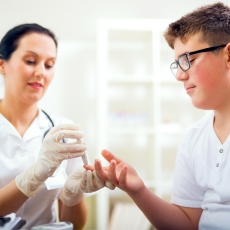

National Institutes of Health
Other Languages
Diabetes means your blood glucose, or blood sugar, levels are too high. With type 1 diabetes, your pancreas does not make insulin. Insulin is a hormone that helps glucose get into your cells to give them energy. Without insulin, too much glucose stays in your blood. Over time, high blood glucose can lead to serious problems with your heart, eyes, kidneys, nerves, and gums and teeth.
Type 1 diabetes happens most often in children and young adults but can appear at any age. Symptoms may include
- Being very thirsty
- Urinating often
- Feeling very hungry or tired
- Losing weight without trying
- Having sores that heal slowly
- Having dry, itchy skin
- Losing the feeling in your feet or having tingling in your feet
- Having blurry eyesight
A blood test can show if you have diabetes. If you do, you will need to take insulin for the rest of your life. A blood test called the A1C can check to see how well you are managing your diabetes.
NIH: National Institute of Diabetes and Digestive and Kidney Diseases
- A1C: MedlinePlus Health Topic
 (National Library of Medicine)Also in Spanish
(National Library of Medicine)Also in Spanish - Blood Glucose Test
 (National Library of Medicine)Also in Spanish
(National Library of Medicine)Also in Spanish - Diagnosis of Diabetes and Prediabetes
 (National Institute of Diabetes and Digestive and Kidney Diseases)Also in Spanish
(National Institute of Diabetes and Digestive and Kidney Diseases)Also in Spanish - Glucose in Urine Test
 (National Library of Medicine)Also in Spanish
(National Library of Medicine)Also in Spanish - Ketones in Blood
 (National Library of Medicine)Also in Spanish
(National Library of Medicine)Also in Spanish - Ketones in Urine
 (National Library of Medicine)Also in Spanish
(National Library of Medicine)Also in Spanish - Microalbumin Test (Mayo Foundation for Medical Education and Research)Also in Spanish
- Diabetes Medicines: MedlinePlus Health Topic
 (National Library of Medicine)Also in Spanish
(National Library of Medicine)Also in Spanish - Islet Cell Transplantation: MedlinePlus Health Topic
 (National Library of Medicine)Also in Spanish
(National Library of Medicine)Also in Spanish - Pancreas Transplantation: MedlinePlus Health Topic
 (National Library of Medicine)Also in Spanish
(National Library of Medicine)Also in Spanish
- 4 Steps to Manage Your Diabetes for Life

 (National Diabetes Education Program)Also in Spanish
(National Diabetes Education Program)Also in Spanish - Changing Your Habits: Steps to Better Health
 (National Institute of Diabetes and Digestive and Kidney Diseases) - PDF
(National Institute of Diabetes and Digestive and Kidney Diseases) - PDF - Checking for Ketones (American Diabetes Association)Also in Spanish
- Getting the Very Best Care for Your Diabetes (American Diabetes Association) - PDF
- Healthy Coping (American Association of Diabetes Educators)
- Living with Type 1 Diabetes (American Diabetes Association)
- Monitoring (American Association of Diabetes Educators)
- Your First Visit (to a Doctor) (American Diabetes Association)
- Your Health Care Team (American Diabetes Association)Also in Spanish
- Causes of Diabetes
 (National Institute of Diabetes and Digestive and Kidney Diseases)Also in Spanish
(National Institute of Diabetes and Digestive and Kidney Diseases)Also in Spanish - Diabetes and Celiac Disease (Gluten Intolerance Group) - PDF
- Diabulimia (National Eating Disorders Association)
- Monogenic Diabetes (Hormone Health Network) - PDFAlso in Spanish
- Speak Up -- Diabetes: Five Ways to Be Active in Your Care at the Hospital (Joint Commission) - PDFAlso in Spanish
- What People with Diabetes Need to Know about Osteoporosis
 (National Institute of Arthritis and Musculoskeletal and Skin Diseases)Also in Spanish
(National Institute of Arthritis and Musculoskeletal and Skin Diseases)Also in Spanish - When You're Sick (American Diabetes Association)Also in Spanish
- Genetics Home Reference: type 1 diabetes
 (National Library of Medicine)
(National Library of Medicine) - Genetics of Diabetes (American Diabetes Association)Also in Spanish
- Diabetes Movie (For Parents)
 (Nemours Foundation)
(Nemours Foundation)
- Age-Adjusted Percentage of Adults Aged 18 Years or Older with Diagnosed Diabetes Performing Daily Self-Monitoring of Blood Glucose, United States, 1994-2010(Centers for Disease Control and Prevention)
- Diabetes in America, 3rd Edition (National Institute of Diabetes and Digestive and Kidney Diseases)
- Experimental Therapy Shows Promise for Type 1 Diabetes
 (National Institutes of Health)Also in Spanish
(National Institutes of Health)Also in Spanish - Infant Formula Not Linked to Diabetes
 (National Institutes of Health)Also in Spanish
(National Institutes of Health)Also in Spanish - Major Long-Term Benefits of Intensive Therapy for Type 1 Diabetes (American Diabetes Association)
- Recent Advances (in Diabetes Research) (American Diabetes Association)
- ClinicalTrials.gov: Diabetes Mellitus, Type 1
 (National Institutes of Health)
(National Institutes of Health)
- Article: Efficacy and safety of dual SGLT 1/2 inhibitor sotagliflozin in type...
- Article: Continuous subcutaneous insulin infusion versus multiple daily injection regimens in children...
- Article: In vitro generation of pancreatic β-cells for diabetes treatment. I. β-like...
- Diabetes Type 1 -- see more articles
- Diabetes: Glossary of Terms (Centers for Disease Control and Prevention)
- American Diabetes Association
- Find a Diabetes Educator (American Association of Diabetes Educators)
- National Eating Disorders Association
- National Institute of Diabetes and Digestive and Kidney Diseases

- NIDDK Information Clearinghouses
 (National Institute of Diabetes and Digestive and Kidney Diseases)
(National Institute of Diabetes and Digestive and Kidney Diseases)
- A1C test (Medical Encyclopedia)Also in Spanish
- Diabetes - low blood sugar - self-care (Medical Encyclopedia)Also in Spanish
- Diabetes - tests and checkups (Medical Encyclopedia)Also in Spanish
- Diabetes - when you are sick (Medical Encyclopedia)Also in Spanish
- Diabetes and exercise (Medical Encyclopedia)Also in Spanish
- Diabetic ketoacidosis (Medical Encyclopedia)Also in Spanish
- Giving an insulin injection (Medical Encyclopedia)Also in Spanish
- Type 1 diabetes (Medical Encyclopedia)Also in Spanish






















.png)











No hay comentarios:
Publicar un comentario